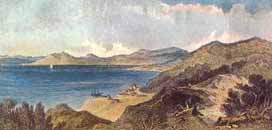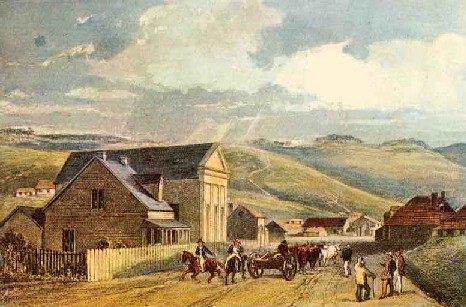 | Twelve months in Wellington / by John Wood (1843)
Chapter 4 |
| Contents: preface | introduction | narrative page 1 | chapters: 1 | 2 | 3 | 4 | 5 | 6 | 7 | 8 | 9 | 10 | |
|
What has been usually promulgated on this subject refers to the country about the Bay of Islands; but that there is a considerable diversity of climate between the north end of the islands and that of Cook's Straits is proved by the fact of Indian corn not being generally grown south of Hawke's Bay. This grain is, indeed, grown the natives on both sides of the straits; but only in small quantities for their own consumption.
 The climate of the one is, therefore, milder than the other. From December, 1841, to the end of 1842, the weather at Port Nicholson was as follows: December (latter half) to April (first half) : Agreeable summer weather; but very windy. May and June : Weather broken, but not too wet; wind still strong. July to December (first half) : The most tempestuous winter, as a whole, I ever experienced. Rain unceasing for many days together and an almost constant gale, blowing often with the strength of a hurricane. The climate of Port Nicholson is boisterous, rather than agreeable. The winds are its scourge ; and yet we have met Company's men in Wellington who profess to like them, and to regret a day's calm. It is otherwise with vegetation, for we are informed by Mr. Swainson that even in the valley of the Hutt crops require shelter screens. Whale-boats are staked down to the beach to prevent their being blown away ; and we have ourselves seen a small jolly-boat twirled round in the air like a hat. A house upon our own town acre had its verandah torn off by the wind ; the poles were dragged out of the ground, and the entire fabric, composed of one-inch plank and heavy rafters, lifted clear over the tops of trees, and carried to another acre some distance beyond the dwelling. Our own house had its verandah consequently secured with ropes ; and every time the sky looked stormy an extra coil was passed along it, and reeved through ring-bolts let into posts sunk deep into the ground. It is really laughable to observe the subterfuges employed by writers in the Company's interest on this subject. The idea of Port Nicholson being a windy place arises, we are gravely told, from most of the Wellington settlers having come from inland English counties. Their draughtsman is positive that it is not more subject to boisterous winds than any town upon the English coast equally exposed. (footnote 1) Our opinion on this point may, perhaps, carry equal weight with Mr. Heaphy's. We know but one place which can be compared to Wellington for wind, and that is Mocha, at the entrance of the Red Sea. (footnote 2) What, however, more than counterbalances this drawback is the healthiness of its site. Disease is a stranger to Port Nicholson ; and it is not possible to conceive a more pleasing scene than the eye embraces, on a still morning, when looking down from Wellington Terrace upon the town and shipping in the harbour.
Footnotes |
